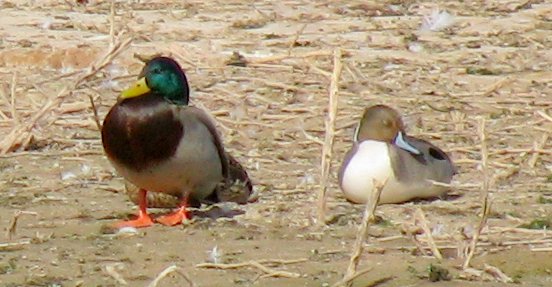 While we were camped in the desert outside Quartzsite, Arizona, we decided to take a road trip to the west. Ten miles down the road, we crossed the state border into California in the car. We passed through one of those agricultural inspection stations, and they didn't even ask if we had fruit on board. But we're guessing they might ask more questions when we drive the motor home across the border about a week from now.
While we were camped in the desert outside Quartzsite, Arizona, we decided to take a road trip to the west. Ten miles down the road, we crossed the state border into California in the car. We passed through one of those agricultural inspection stations, and they didn't even ask if we had fruit on board. But we're guessing they might ask more questions when we drive the motor home across the border about a week from now. The Colorado River is the dividing point between Arizona and California in this part of the state. We got a good view of the river, where we decided that it was flowing too fast to try paddling the kayak upstream and floating back. So today, we'll just view the Colorado River from the bank.
The water from the Colorado River is used for irrigation, and as we drove across the California country-side, we saw water canals criss-crossing the desert.
Instead of desert sand, there are beautiful green fields of vegetables as far as the eye can see. This crop of onions was divided by furrows that are flooded to water the plants. We had our windows rolled down, and we could smell the onions as we drove by.
Denisa thinks that rows of vegetables are as pretty as flower gardens. Each cabbage is formed in the middle of a rosette-shaped plant.
We thought that it looked like the cabbage was ready for harvest. Sure enough, there was a tractor-powered harvest platform parked at the edge of the field.
Crews walk behind, bending over to cut the cabbage from the plant. They lay each head on the platform, where more workers are folding boxes, and filling them with those fresh heads of cabbage.
We enjoyed our agricultural tour through the country-side, but our real destination was Cibola National Wildlife Refuge. The visitor center was closed, but it posted the number of birds residing in the park this season: 1,650 sandhill cranes; 2,850 Canada geese; 1,750 snow geese; 20 white-fronted geese; 5 burrowing owls; 15,000+ ducks. We think we found most of these birds on the little lake not far from the visitor center. They were packed together like their human counterparts--snow birds wintering in Arizona in RV parks.
Here is a close-up of a few of those 1,750 snow geese. They are a long ways from home, as they spend their summers north of the timberline in Canada and Alaska.
Among the 15,000 ducks here, we took a close-up of a couple of our favorites.
Something spooked a flock of mallards, and it was neat to watch and hear as hundreds of them took to the air at once.
We drove the loop trail, and hiked the nature trail. The wildlife refuge had set up man-made homes to entice the burrowing owls to nest here. This guy was coming out of his new condo to check out the traffic.
Of the 5 burrowing owls reported at the visitor center, we saw two of them. This second bird had his back to us, but could still keep an eye on our progress by rotating his head.
Owls can turn their heads all the way around backwards. That made it easy for him to give us that squinty-eyed-I'm-watching-you glare.
Instead of worrying about us, the owls should have been more concerned about this coyote lying on the ridge not far away.
He rose to his feet to let us know that he was watching us as well. It's always fun to spot some wildlife in a wildlife preserve!
As we drove back towards home, we passed more of the beautifully aligned vegetable fields that fascinate us. But we also saw a more familiar crop--alfalfa. We saw it being cut, and baled, and bales being automatically stacked with new-fangled hay-hauling machines. Mark worked as a hay-hauler while we were dating, and he developed some good muscles from stacking those bales by hand. Too bad this generation of farm laborers will miss out on that.
We haven't seen any cattle in the desert, so we were wondering where all these alfalfa bales were heading. Mark read that most will be shipped to China, Japan, and the Middle East. Those countries don't have enough water to grow alfalfa for their beef and dairy herds, so they must pay the hefty freight to deliver it half-way around the world! Mark also read that Saudi Arabia is buying up these fields in the desert Southwest of the U.S., especially those with water rights to receive that precious water through the canal system.
We start and finish this blog with pictures of the mighty Colorado River. It has turned parts of this desert into an oasis of green that makes for a beautiful road trip, as we cross the river back into Arizona.

Another educational part of this road trip to California was seeing the price of fuel across the state line. The gas station just a few miles down the road into California priced gasoline at 90 cents more per gallon. Before we cross the state line in the motor home, you can be sure that we'll be filling up that 100-gallon diesel tank in Arizona.
We were back to the motor home in time for sunset over the desert at Dome Rock BLM campground. It has been a good boondocking stay, but we're ready for some water and electric hook-ups as we head down the road to new adventures.





























0 Response to "Road trip to California"
Post a Comment